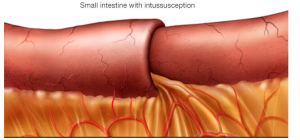Overview
Kaposiform hemangioendothelioma (KHE) may look like a birthmark, but is actually a rare benign tumor caused by the abnormal growth of blood vessels, diagnosed in infancy or early childhood It can appear anywhere on the body, often on the head and neck but also on the stomach, back, arms, and legs — even inside the chest, abdomen, or bones. Although KHE can grow, it doesn’t spread to other locations in a child’s body. A mild form of KHE, called tufted angioma, is less likely to cause complications or require treatment. Researchers are still searching for the cause of KHE. It is not inherited, and while it typically occurs in infancy, Magnetic resonance imaging (MRI) is generally first-line assessment because the deep infiltrating nature of KHE may not be apparent on physical exam or on ultrasound. MRI with and without gadolinium has the most value in the diagnosis of KHE as well as for clearly determining the extent of involvement and response to treatment. Some mild KHE tumors go away without treatment. For those that do not, doctors have multiple treatment options available to them, depending on the size, location, and behavior of the tumor. The goals of treatment are to relieve symptoms, shrink the tumor, and reverse Kasabach-Merritt, if it is present. Further clinical studies are also needed to refine the guidelines for the standard use of therapies and follow-up in patients with KHE.
Symptoms
The exact symptoms of KHE depend on where the lesion appears. The most common symptom of KHE is a growing lesion on the skin. This lesion:
- Is usually a deep reddish-purple and has poorly defined edges
- Is firm and warm to the touch
- Often has shiny and tense skin
- May be accompanied by a bruise-like discoloration nearby, or tiny red or purple spots (petechiae) anywhere on the body
- Sometimes swells and becomes painful, or causes pain with movement or reduced range of motion
The exact symptoms of KHE depend on where the lesion appears. About 10 percent of children with KHE have no skin lesion, and some lesions penetrate deeper than the skin into other tissues.
Most children have few complications and may not need medical therapy. Some patients with KHE, however, develop what is called Kasabach-Merritt phenomenon (KMP), in which their tumor traps platelets and keeps them from circulating through the bloodstream. Because platelets help prevent bleeding, patients with KMP have a higher risk of bleeding.
KMP may develop in patients whose tumors are larger, invade into deeper tissues, or if there are sites of infection or inflammation nearby. Some children who develop KMP also lack other blood proteins that help control bleeding, such as fibrinogen.
Causes
Causes for Kaposiform hemangioendothelioma (KHE) is unknown, Researchers are still searching for the cause of KHE. It is not inherited, and while it typically occurs in infancy, KHE can arise prenatally or in adults after trauma.
Diagnosis
The first step in treating your child is forming an accurate and complete diagnosis. An experienced vascular anomalies specialist can help tell the difference between KHE and other vascular anomalies.
Most often, KHE is diagnosed through a complete medical history, a thorough physical exam and one or more of the following tests:
- Complete blood count
- Magnetic resonance imaging (MRI)
- Ultrasound
- Biopsy
Treatment
Some mild KHE tumors go away without treatment. For those that do not, doctors have multiple treatment options available to them, depending on the size, location, and behavior of the tumor. The goals of treatment are to relieve symptoms, shrink the tumor, and reverse Kasabach-Merritt, if it is present.
Treatment options include:
- Watchful waiting: For superficial tumors without low platelets, your child’s doctor may want to observe the tumor for a few months before determining the most appropriate treatment.
- Oral or topical steroids: In mild cases, oral or topical steroids may help other treatments work better and improve superficial lesions. However, only about 12 percent of KHE tumors respond to steroids.
- Drug therapy: Considered the gold standard treatment for most tumors, medications slow the growth of the tumor and improve symptoms.
- Surgery: Your doctor will only recommend surgery if your child’s tumor is very small or extremely aggressive and able to be completely removed.
- Embolization: This minimally invasive procedure blocks the main artery feeding a KHE tumor to cut off the blood supply and shrink it. We do not attempt embolization in cases where several arteries feed into the tumor, which is often the case with KHE.
Medications
Medications used to treat KHE include:
- Sirolimus: Also known as rapamycin, this oral medication suppresses the immune system and slows the growth of abnormal lymphatic vessels that form the tumor. It has been found to shrink KHE tumors and improve symptoms, including pain.
- Vincristine: This chemotherapy drug targets all dividing cells within the body and is therefore used to treat many cancers. While KHE is not a cancer, there are dividing cells in the tumor. Vincristine has been used successfully for decades to treat KHE.
Many patients have an excellent long-term outlook through successful KHE treatment. In general, you child’s prognosis depends on:
- How quickly the diagnosis is made and appropriate medical therapy is started
- The size, location, and extent of disease
- The tumor’s initial response to therapy
When KHE is suspected, it’s important to see a specialist quickly to allow early discussions about treatment. Specialists can then attempt to shrink the tumor before it affects muscles or other tissues nearby. Early treatment could also help reduce long-term complications by preventing further growth.
To Conclude if you come across any of you close ones with this type of disease or any such kind you can direct the patient to us or share us the latest medical history with reports via email : query@gtsmeditour.com or whatsapp the same on +91 9880149003 and get the genuine second opinion, which help you decide further and take firm decision.
Thank you..!











